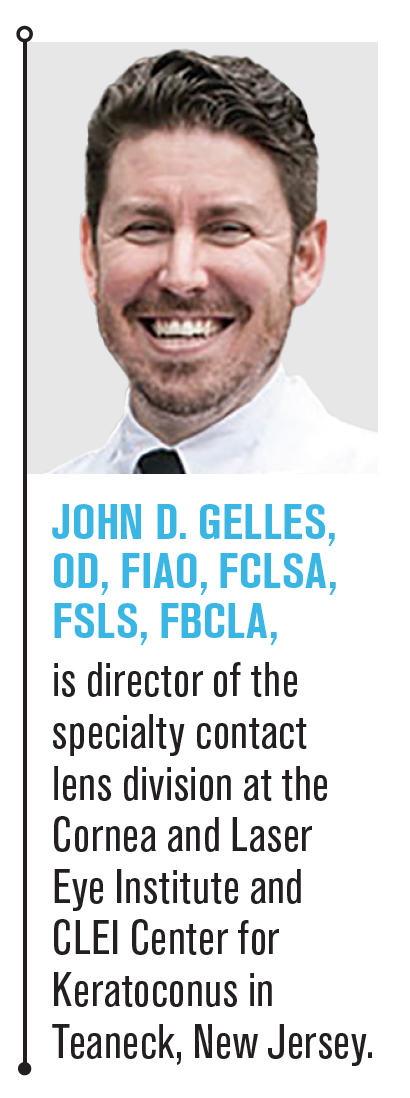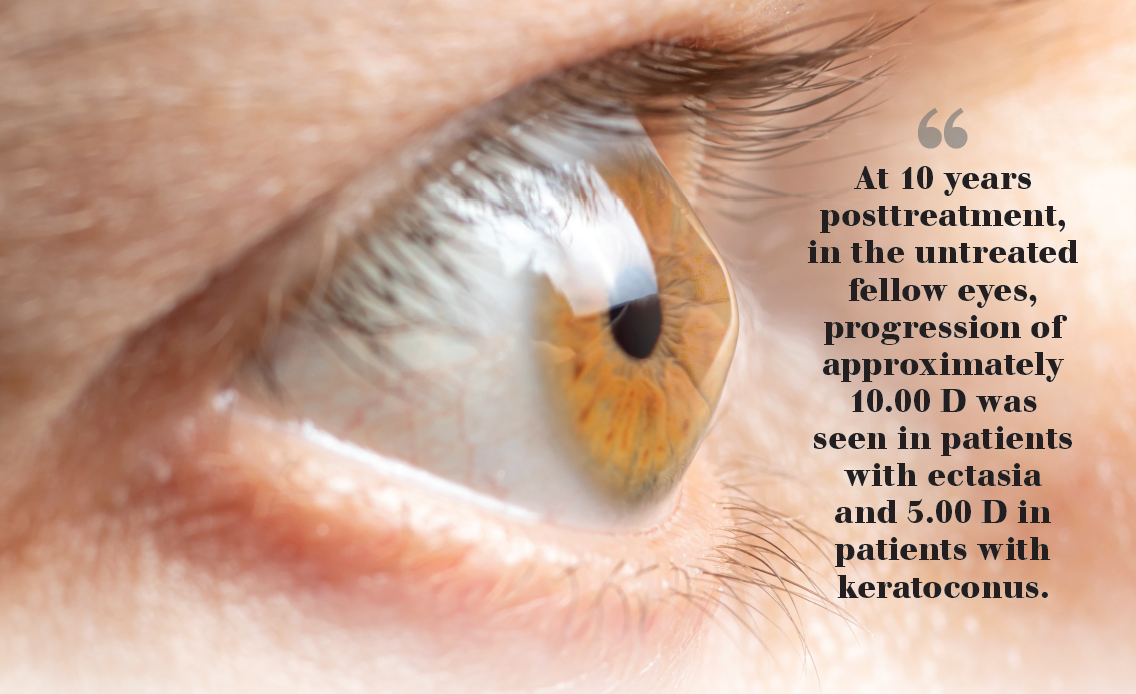Long-term outcomes of corneal cross-linking
Most treated eyes remained stable 10 years after the initial treatment


Corneal collagen cross-linking was approved for use in the United States in 2016 following successful phase 3 clinical trials in patients with progressive keratoconus and ectasia after refractive surgery.1,2 Patients treated in these pivotal trials are now 10 years out from their cross-linking treatments. Clinicians at our treatment center have begun the process of evaluating long-term results of patients treated in our center where the director and founder of our center served as medical monitor and principal investigator of the 2 aforementioned multicenter clinical trials.
Our single-center preliminary analysis of 26 eyes (20 treated eyes, 6 untreated fellow eyes) of 16 patients from the pivotal trials demonstrates that most cross-linked eyes remained stable 10 years after treatment with no significant adverse events or safety concerns. For this study, progression was defined as >2.00 D or more of maximum keratometry or >2 or more logMAR lines loss of uncorrected and spectacle-corrected visual acuity. Data collection and analysis are ongoing.
This is important information for eye care practitioners and patients. Although cross-linking has been performed internationally since 1997 and substantial evidence exists of efficacy and safety out to 6, 7, or 10 years in Europe,3-5 the studies outside the United States included a variety of technologies and treatment protocols.
By contrast, the patients we evaluated were treated with the standard epithelium-off protocol using the clinical study light source, Photrexa Viscous (riboflavin 5’-phosphate in 20% dextran ophthalmic solution; Glaukos), and Photrexa (riboflavin 5’-phosphate ophthalmic solution; Glaukos). The output specifications of the clinical study light source are identical to the FDA-approved KXL system used in the Glaukos iLink procedure, so the findings of this study are directly applicable to the U.S. clinical experience.
Keratoconus
In the treated eyes with keratoconus, no statistically significant differences were shown between the 1-year and 10-year corneal topography, pachymetry, and visual acuity outcomes, indicating stability of the treatment effect. Looking at the results by percentage of stable eyes, approximately 90% of these patients with keratoconus had stable corneal topography a decade after undergoing cross-linking, which is consistent with European data.
In contradiction to this stability, the untreated eyes experienced a significant increase in maximum keratometry (Kmax), thinning of thinnest pachymetry (Pthin), and a worsening of uncorrected visual acuity and best-corrected visual acuity, respectively.
This long-term stability had a positive effect on the patients’ quality of life and the cost of care. A recent economic analysis demonstrated that patients with keratoconus who have had cross-linking are less likely to undergo penetrating keratoplasty and will spend nearly 28 fewer years in the advanced stages of the disease. Over a lifetime, the model suggests they will have more quality-of-life years and a cost savings of $43,759 per patient.6

Ectasia
A smaller subset of patients underwent cross-linking for postrefractive surgery ectasia. More variability and progression was seen in some of these eyes. The treated eyes still performed substantially better than untreated fellow eyes. This indicates that patients with ectasia required closer and long-term follow-up even after cross-linking treatment.
A number of possible reasons exist for different outcomes in the ectasia group. Ectasia may simply be a less predictable or more aggressive condition. Or it may be that further improvements are needed in the current approach to cross-linking for ectasia. In the pivotal clinical trials, keratoconus eyes achieved more flattening of the Kmax (1.6 D) than the ectasia eyes (0.70 D) at 1 year.1,2 At present, cross-linking treatments target the central 9.0 mm of the cornea. In eyes with postrefractive ectasia, the ectatic region may be more peripheral and thus not as effectively treated.7 Future innovations may allow for topography-guided, customized treatments or other modifications that may deliver a more focal cross-linking treatment to the weakened area of the peripheral inferior cornea.
Monitoring after cross-linking
Interestingly, many patients in our study had been lost to follow-up after the clinical trial and returned to the office for the 10-year exam only after persistent and repeated efforts.
Thus, a clear message that emerges from our data is that regular monitoring of patients, whether they have undergone cross-linking or not, is essential and should be discussed with all patients undergoing cross-linking.
At 10 years posttreatment, in the untreated fellow eyes, progression of approximately 10.00 D was seen in patients with ectasia and 5.00 D in patients with keratoconus. At baseline, these fellow eyes had subclinical disease or only mild disease, but they were still at high risk for progression. Had these patients been examined at the recommended intervals over the past decade, their fellow eyes could have been treated as well and likely avoided the same degree of progression.
Additionally, age was not shown to be protective, particularly with ectasia. Patients with ectasia (and especially their untreated eyes) continued to experience progression well into their 50s and 60s. As noted, ectasia may be a less stable condition and it is important to have this conversation with these patients, particularly that there may be of a greater possibility of needing a second treatment over time.
In monitoring patients postcross-linking or those who are at risk for ectatic disease, it is also important to be aware of the influence contact lens wear may have on topographic accuracy. For this 10-year exam, we required patients to stop contact lens wear before the exam. Although pausing contact lens wear is difficult for patients, it is essential for accurate corneal maps.
Conclusion
Preliminary 10-year follow-up data demonstrated that iLink corneal collagen cross-linking is effective at stabilizing corneal topography (Figure 1) and visual acuity over the long term in patients with progressive keratoconus or ectasia after refractive surgery. Final outcomes of the study will be reported later this year. Clinicians should be aware that a small percentage of treated eyes may continue to progress. Despite the cornea becoming more stable after cross-linking, postoperative monitoring is still required, particularly in patients with postrefractive corneal ectasia.
References
1. Hersh PS, Stulting RD, Muller D, Durrie DS, Rajpal RK; US Crosslinking Study Group. United States multicenter clinical trial of corneal collagen crosslinking for keratoconus treatment. Ophthalmology. 2017;124(9):1259-1270. doi:10.1016/j. ophtha.2017.03.052
2. Hersh PS, Stulting RD, Muller D, Durrie DS, Rajpal RK; US Crosslinking Study Group. US multicenter clinical trial of corneal collagen crosslinking for treatment of corneal ectasia after refractive surgery. Ophthalmology. 2017;124(10):1475-1484. doi:10.1016/j.ophtha.2017.05.036
3. Poli M, Lefevre A, Auxenfans C, Burillon C. Corneal collagen cross-linking for the treatment of progressive corneal ectasia: 6-year prospective outcome in a French population. Am J Ophthalmol. 2015;160(4):654-662e1. doi:10.1016/j. ajo.2015.06.027
4. O’Brart DP, Patel P, Lascaratos G, et al. Corneal cross-linking to halt the progression of keratoconus and corneal ectasia: seven-year follow-up. Am J Ophthalmol. 2015;160(6):1154-1163. doi:10.1016/j.ajo.2015.08.023
5. Raiskup F, Theuring A, Pillunat LE, Spoerl E. Corneal collagen crosslinking with riboflavin and ultraviolet-A light in progressive keratoconus: ten-year results. J Cataract Refract Surg. 2015;41(1): 41-46. doi:10.1016/j.jcrs.2014.09.033
6. Lindstrom RL, Berdahl JP, Donnenfeld ED, et al. Corneal cross-linking versus conventional management for keratoconus: a lifetime economic model. J Med Econ. 2021;24(1):410-420. doi:10. 1080/13696998.2020.1851556
7. Greenstein SA, Fry KL, Hersh PS. Effect of topographic cone location on outcomes of corneal collagen cross-linking for keratoconus and corneal ectasia. J Refract Surg. 2012;28(6):397- 405. doi:10.3928/1081597X-20120518-02
Newsletter
Want more insights like this? Subscribe to Optometry Times and get clinical pearls and practice tips delivered straight to your inbox.